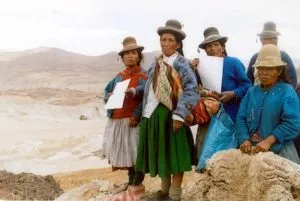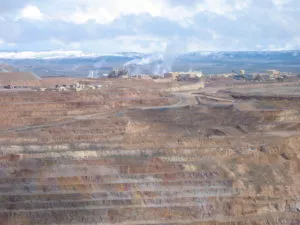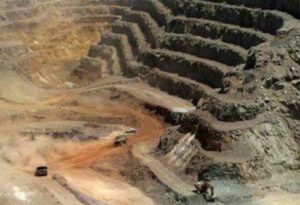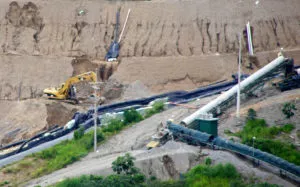Most consumers don’t know where the gold in their products comes from, or how it is mined. Gold mining is one of the most destructive industries in the world. It can displace communities, contaminate drinking water, hurt workers, and destroy pristine environments. It pollutes water and land with mercury and cyanide, endangering the health of people and ecosystems. Producing gold for one wedding ring alone generates 20 tons of waste.
Poisoned Waters
Gold mining can have devastating effects on nearby water resources. Toxic mine waste contains as many as three dozen dangerous chemicals including:
- arsenic
- lead
- mercury
- petroleum byproducts
- acids
- cyanide
Mining companies around the world routinely dump toxic waste into rivers, lakes, streams and oceans – our research has shown 180 million tonnes of such waste annually. But even if they do not, such toxins often contaminate waterways when infrastructure such as tailings dams, which holds mine waste, fail.
According to the UNEP there have been over 221 major tailings dam failures. These have killed hundreds of people around the world, displaced thousands and contaminated the drinking water of millions.
The resulting contaminated water is called acid mine drainage, a toxic cocktail uniquely destructive to aquatic life. According to one study: “The effects of AMD are so multifarious that community structure collapses rapidly and totally, even though very often no single pollutant on its own would have caused such a severe ecological impact.”
These same “multifarious impacts” also makes recovery from such wastes much more difficult.
This environmental damage ultimately affects us — in addition to drinking water contamination, AMD’s byproducts such as mercury and heavy metals work their way into the food chain and sicken people and animals for generations.
The Biggest Polluters:
The top four mines that dump tailings into bodies of water account for 86% of the 180 million tonnes dumped into bodies of water each year. Those mines are:
- Freeport McMoRan and Rio Tinto’s Grasberg mine in West Papua, Indonesia, which accounts for approximately 80 million tonnes of tailings
- Newmont Sumitomo Mining’s Batu Hijau mine in Indonesia, which accounts for approximately 40 million tonnes
- Ok Tedi Mining Ltd.’s Ok Tedi mine in Papua New Guinea, which accounts for approximately 22 million tonnes
- Cliff’s Mining Company’s Wabush/Scully mine in Labrador, Canada, which accounts for 13 million tonnes of tailings
Of the over 2,000 major mining companies in the world only one company, BHP Billiton, is taking steps to avoid catastrophes like this from recurring.
For More Information
- Earthworks Ruined Lands, Poisoned Waters. A section from Dirty Metals: Mining Communities and the Environment.
- Earthworks Troubled Waters: How Mine Waste Dumping is Poisoning Our Oceans, Rivers, and Lakes
- Earthworks EARTHblog: Report from the field: Tailings dam fails at silver mine in Turkey
- Earthworks Cyanide Factsheet
- Earthworks Mining Pollutes the World’s Waterways
- Earthworks Acid Mine Drainage
- Earthworks Mercury
- Earthworks Fort Belknap Reservation
- Chronology of major tailings dam failures
- BBC Report
- Earthworks EARTHblog: Troubled Waters – and no bridge to cross them
Solid Waste
Digging up ore displaces huge piles of earth and rock. Processing the ore to produce metals generates immense quantities of additional waste, as the amount of recoverable metal is a small fraction of the total ore mass. In fact, the manufacture of an average gold ring generates more than 20 tons of waste.
Heap Leaching
Many gold mines employ a process known as heap leaching, which includes dripping a cyanide solution through huge piles of ore. The solution strips away the gold and is collected in a pond, then run through an electro-chemical process to extract the gold.
This method of producing gold is cost effective but enormously wasteful: 99.99 percent of the heap becomes waste.
Gold mining areas are frequently studded with these immense, toxic piles. Some reach heights of 100 meters (over 300 feet), nearly the height of a 30-story building, and can take over entire mountainsides.
To cut costs, the heaps are often abandoned. Contaminated water, containing cyanide and other dangerous chemicals, can often contaminate groundwater and poison neighboring communities such as Miramar, Costa Rica.
Toxic Releases
Metal Mining was the number one toxic polluter in the United States in 2010. It is responsible for 1.5 billion pounds of chemical waste annualy- more than forty percent of all reported toxic releases. In 2010, metal mining released the following in the United States:
- over 200 million pounds of arsenic
- over 4 million pounds of mercury
- over 200 hundred million pounds of lead
Find who releases what in your part of the country by exploring the Environmental Protection Agency’s 2010 Toxic Release Inventory, or the web-based public-art project Superfund365.
For More Information
- Earthworks Cyanide Heap Leach Packet
- Earthworks Cyanide Fact Sheet
- EPA Mining Waste
- EPA Toxic Release Inventory EnviroFacts
- Brooke Singer’s web-based public-art project Superfund365
- Find user-friendly information from the Toxic Release Inventory at Scorecard.com
- Video on heap leaching proposed in Australia
- Earthworks Costa Rica | Puntarenas | Miramar : Glencairn Gold
- Earthworks Earthblog Costa Rican Gold Mine Suspended Due to Pollution Risks
Threatened Natural Areas
The mining industry has a long record of threatening natural areas, including officially protected areas.
Nearly three-quarters of active mines and exploration sites overlap with regions defined as of high conservation value. Mining is a major threat to biodiversity and to “frontier forest” (large tracts of relatively undisturbed forest).
The spotlighted mine sites below reveal the state of natural degradation caused by mining around the world:
The Grasberg Mine, Indonesia:
The Indonesian province of West Papua, which is the western half of the island of New Guinea, is home to Lorentz National Park, the largest protected area in Southeast Asia.
This 2.5 million-hectare expanse — about the size of Vermont — was declared a National Park in 1997 and a World Heritage site in 1999. But as early as 1973, Freeport-McMoRan Copper and Gold, Inc., had begun chasing veins of gold through nearby formations.
This operation eventually led to the discovery of the world’s richest lode of gold and copper, lying close to the park boundary. The resulting open-pit mine, Grasberg, operated by its subsidiary PT Freeport Indonesia, has already:
- contaminated the coastal estuary and Arafura Sea and possibly the Lorentz National Park
- led to local violence and strikes
- dumped 110,000 tons of toxic mine tailings a day into the Ajikwa river
- triggered deadly landslide
The Grasberg mine is now visible from outer space. By the time it closes in 30 years, it will have excavated a 230 square-kilometer hole in the forest and produced over three billion tonnes of tailings.
Akyem Mine, Ghana:
After a contentious struggle with community protests, Newmont opened the Akyem mine in Ghana in 2007. This open-pit mine is the largest in Ghana and will destroy some 183 acres of protected forests.
Much of Ghana’s forested land has been denuded over the past 40 years. Less than 11 percent of the original forest cover remains. This biodiversity hotspot supports 83 species of birds, as well as threatened and endangered species such as Pohle’s fruit bat, Zenker’s fruit bat, and Pel’s flying squirrel.The forest reserves of Ghana are also extremely important for protecting many rare and threat- ened plant species.Many community members opposed construction of the Akyem mine, for its potential to contaminate freshwater and destroy the forests on which they depend. The mine is expected to begin operations in 2013.
Pebble Mine, US:
If developed, the Pebble Mine in Bristol Bay, Alaska, could be the largest mine in North America, covering over 15 square miles (39 square kilometers) of land and generating more than 3 billion tons of mine waste over its life.
The company proposes to withdraw more than 70 million gallons (265 million liters) of water per day, nearly three times the amount of water used in the city of Anchorage. This insatiable demand for water is a major threat to the Bristol Bay watershed, which supports the world’s largest sockeye salmon run and commercial sock- eye salmon fishery.116 Salmon, caribou, moose, and the many other fish and wildlife resources of the Bristol Bay watershed are also vital to the subsistence way of life of Alaska Native people, as well as key economic drivers in the state.
The Pebble Project and associated development are opposed by a strong and diverse constituency. The Alaska Inter-Tribal Council, a consortium of 231 federally recognized tribes in Alaska, and many tribal governments of the region have all passed resolutions against the project.119 Commercial salmon fishing businesses, premier Alaska hunting and fishing lodges, fishing and conservation groups, and the Alaska Wilderness Recreation and Tourism Association have expressed opposition, as has Alaska’s senior US senator, Ted Stevens.
Mining the Parks:
The UNESCO World Heritage Convention was designed to identify and protect areas around the world whose cultural and natural value is of “outstanding value to humanity.” Placement on the list requires requires extra protection for these special areas whose natural or cultural area extend far beyond local or national borders. Unfortunately, as detailed in our Dirty Metals report, mining companies have even encroached into these areas. Some of the special places that gold mining companies have encroached upon include:
- Okapi Wildlife Reserve, DRC
- Southeast Atlantic Forest Reserve, Brazil
- Sangay National Park, Ecuador
- Huascaran National Park, Peru
- Volcanoes of Kamatchhka, Russia
- Central Suriname NAture Reserve, Suriname
- Bwindi Impenetrable National Park, Uganda
- Kahuzi-Biega National Park, Congo
For More Information
- Last Frontier Forests: Ecosystems and Economies on the Edge
- Description of New Guinea’s Lorentz National Park from UNESCO
- Condemnation of Freeport-McMoRan Copper and Gold, Public Eye People’s Award
- Report on the Grasberg Mine, “Below a Mountain of Wealth, a River of Waste.” New York Times 2005
- Report on a strike at the Grasberg Mine, “Indonesia strike hits Freeport’s Papua copper mine.” BBC 2011
- Report on deadly violence during the strike. “Three dead at Papua Freeport mine, as strike continues.” BBC 2011
- Earthworks Troubled Waters
- NASA Earth Observatory‘s picture of the Grasberg Mine from space
- A report of one of the massive landslides at the Grasberg Mine, “Landslide leaves thousands stranded at Indonesia mine.” Rueters 2011
- World Heritage Sites in danger, “Mining threats on the rise in World Heritage sites.” IUCN 2011
Golden Rule
Ensure that projects are not located in protected areas, fragile ecosystems, or other areas of high conservation or ecological value.





